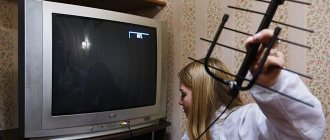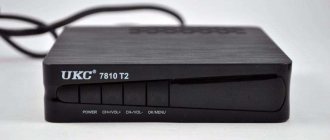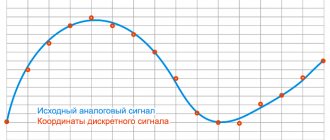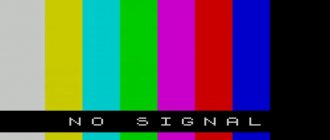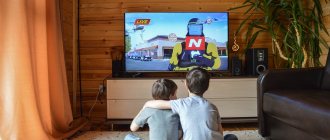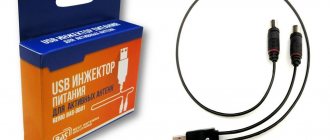Is there interference on the TV screen and the picture is scattered? Does digital TV show poorly? What to do?
There may be several reasons why digital television does not show today, from simple and easy to fix to more complex:
- The wave channel antenna is not precisely aligned towards the repeater;
- High-quality reproduction of digital channels is hampered by induced interference from wires on power lines and nearby transmitters for various purposes - from military to cellular towers;
- Poor contact. In the antenna connector of the TV, the cable is poorly soldered to the antenna or the integrity of the RF cable braid is damaged;
- The distance to the repeater is too large, not corresponding to the height and power of your antenna;
- Terrain with large elevation differences and dense forest on the radio route to the television transmitter;
Let's take a closer look at each of the possible causes and solutions to the problem.
How to determine the direction to a repeater
If you have an antenna of the wave channel type (a metal rod on which several perpendicular elements are located - the so-called “directors”), then it is very important how accurately it is aimed at the repeater and works well only if there is a direct line of sight to the transmitter.
To find out the nearest town where the tower is located, use the tower location map
Panel-type antennas (the so-called patch, several rectangular elements hidden under a plastic casing) are less sensitive to direction and are able to receive a reflected signal. Optimal for uneven terrain and wooded areas.
Lack of contact in the connector, broken RF cable and electromagnetic interference
You must be sure that there are no sources of electromagnetic radiation nearby that cause interference and lead to poor quality digital television. Try to lay the cable separately from the wiring. Then check how well the RF connector of the antenna cable connecting to the TV is screwed onto the wire braid, which serves as ground. The contact must be reliable. Also check whether the central core goes all the way into the connector on the TV. Before experiments, you need to turn off the power to the TV and antenna amplifier.
Connecting multiple TVs to one set-top box
Often there are several TV receivers in one house. Is it possible to connect them to the same receiver so that family members can watch them without disturbing each other?
When connecting “digital”, the signal goes directly to the screen and to the speakers. Therefore, the TV will only show what the set-top box is currently broadcasting to it.
Therefore there are two options:
- If you are satisfied that both TVs will transmit the same image with synchronous sound, you can use a cable divider to connect them to the corresponding outputs on the set-top box. If there are any problems, it will only be with signal attenuation if the cable has too high a resistance.
- If you want to watch different channels on 2 or more TVs, you need to buy a divider for the antenna cable and a second receiver. There is no way around this problem.
We recommend that you familiarize yourself with all the ways to connect multiple TVs to one set-top box. Is it difficult to connect the set-top box yourself?
Video: How to connect the antenna cable to the plug
There is another common source of interference - mobile base stations operating in the 450-900 megahertz range, located next to the TV repeater.
The problem when the TV does not pick up digital channels well due to interference is solved by using a narrowly directional antenna such as a wave channel, “shooting” a beam of the radiation pattern exactly at the TV repeater. Also, depending on the source of interference, specialized filters are used, which are placed directly behind the antenna, but in front of the amplifier. For LTE 450 frequency - a low-pass filter, for LTE 800 and 900 together with GSM 900 - a high-pass filter.
The distance to the repeater is too large and does not correspond to the height and power of your antenna
When the distance to the repeater is over 25 kilometers, it makes sense to use a highly efficient antenna with a built-in amplifier. The total gain of such a system can reach 30 decibels or more. To realize the potential of the amplifier, you must achieve a good signal-to-noise ratio - raise the equipment to the highest possible height.
Other factors that affect signal strength may include air humidity, precipitation, and tree foliage. If the quality of the television picture changes from day to day, try changing the antenna system to a more powerful one. The most obvious way to catch digital TV is to install an external Wave Channel antenna with side reflectors.
Setting up TV channels
In order to configure your TV set-top box to receive as many channels as possible, you will most likely have to use manual channel tuning. In this case, you need to know that channels are broadcast in packages, multiplexes, at different frequencies. The first package contains the following channels:
Channel One, Russia 1, Match TV, TVC, Karusel, OTR, Russia 2, Channel 45, NTV, Russia Culture.
Receiving broadcasts from the second multiplex gives access to:
MuzTV, RenTV, STS, Spas, TV3, Friday, Domashny, Mir, Zvezda, TNT.
Also, do not forget that, unlike analog channels, the search for digital channels on the set-top box occurs by packets, and not by channels. This means that nothing will happen on the TV screen for several minutes, and then 10 channels will immediately become available.
It is also worth periodically monitoring information about available free channels etc. if necessary, update the found packages.
You have learned how to set up digital television through a set-top box, all that remains is to deal with possible problems with this.
Where to turn if digital television does not work well?
If your digital TV reception is poor, you will need a more powerful antenna, which can be purchased at specialized stores. Please note that some sellers and antenna system manufacturers overestimate the gain for marketing purposes. Sellers from Chinese sites are especially guilty of this. As a result, the consumer is disappointed with the result.
To choose a television antenna with maximum gain, you should pay attention to the size and number of elements. Indeed, to achieve each subsequent decibel of gain, designers are forced to increase the dimensions of the antenna. Which also affects the nuances of application. The presence of side reflectors (reflectors) also speaks in favor of the fact that the declared gain approximately corresponds to reality.
Therefore, an antenna of the wave channel type (in other words, Yagi) 2 meters long has maximum gain; the presence of developed side reflectors gives another 1-2 decibels of gain. A panel antenna for a TV should also be chosen without deviating from this principle - the more elements in the patch, the better.
As a rule, the best antenna manufacturers have their production facilities in the Russian Federation - KROKS, Antex, Bester . The antennas of these manufacturers have optimal SWR parameters and radiation patterns.
The use of highly efficient antennas with extreme gain has its own nuances. According to the physics of propagation of radio waves in the decimeter range, a high-gain antenna has a narrow radiation pattern. This means that in order for the antenna to work at full strength, precise adjustment of the direction to the TV transmitter is required.
Recommendations for selection
So, how to strengthen the digital television signal? First you need to choose a good amplifier that will work in a particular case.
To begin with, find out in what range the broadcast is made in your region: it can be meter and decimeter. In the first case, the maximum frequency is 300 MHz, and in the second – 3 Hz.
Amplifiers are single-range, i.e. work only in one mode, and are universal with a switch. This is the main indicator that you should pay attention to.
However, it is also recommended to study the following:
- Reception range. The minimum range is 30 km, but 150 is better! The indicator indicates the distance between your receiver and the repeater point. It makes no sense to put everything below 30 km, because... there will be almost no effect. Anything more is wasteful, because... Such amplifiers are expensive.
- Reception gain factor. How to improve the signal? Of course, you need to look at how much the amplifier can increase reception. The rule here is: “The further away the repeater, the higher the coefficient.” For a distance of 50 km, a gain of 27 dB is sufficient, i.e. ratio: 1 dB at 1.85 km.
- Nutrition. Some models are powered by a power supply, others by a receiver. According to customer reviews, the first models work better. On the other hand, the latter are much more convenient, because You just need a long USB cable.
- Frame. Depends on the installation location. Models with a plastic body are suitable for indoor use, and metal ones for outdoor use.
TOP 4 good amplifier
1 Model SWA9001/999/9701 (L) broadband. A good broadband amplifier without adjustment. Suitable for both home installation and mast installation. It is recommended to install an additional metal screen. Capable of picking up a signal up to 100 km.
2 Televes. A good 5-output Italian amplifier with a gain of 15 dB. The signal increase is not very large, but excellent noise reduction is provided. Powered by the included power supply.
3 Gecen A05-02. Satellite and digital amplifier operating in both the meter and decimeter range. It is powered via a coaxial cable, which is not very good, but there is no need to purchase an additional power supply or USB.
4 RTM LNA02. An excellent model with a gain of 20 dB. It has excellent noise reduction and is powered by the receiver. Well suited for broadcast-restricted areas.
Why does digital television show so poorly: unfavorable terrain
The quality of reception depends on the terrain. If the conditions are very unfavorable, then even rising to a high altitude may not produce tangible results in improving the quality of reception.
The slides in front of you will completely block the transmission of the TV transmitter signal. Since the signal at decimeter waves tends to be reflected from the ground and various objects, to improve the quality of reception, sometimes it is not necessary to raise the antenna to a greater height. A high-gain panel antenna or even a homemade one - the most common - Kharchenko .
It also makes sense to experiment with antenna location and polarization (position in space). A typical wave channel antenna has horizontal polarization. So that then it doesn’t become bad to show the installation of a high mast cannot be avoided
In order to preliminary evaluate the properties of the radio path (the difference in height from the transmitter to the receiving antenna of the TV), there are convenient online services. Of the new ones, Linktest is the most convenient for beginners. You can also use the “classic” online service from Micran.
Antenna for difficult signal reception conditions
For example, the active antenna in the photo below, in our area, pulls out a signal from a distance of 60 km or more. It is successfully used in the most difficult places, in houses located in deep lowlands, its length is approximately 1.7 meters, but there are antennas up to 4 meters in length.
In addition to the length, in difficult conditions or at a great distance from the TV tower, the presence of an amplifier plays an important role, i.e. the antenna must be active.
There are options for powerful antennas, where instead of one boom, three are used at once, so the ability of the antenna to amplify the signal due to the design alone is greatly increased.
And in tandem with an amplifier, this antenna becomes a very powerful trap for a television signal.
But once you’re impressed with this antenna, don’t rush to run after it. It is only needed under really, really difficult reception conditions.
In most cases, other, much cheaper options are sufficient. In addition, if the signal in your area is already strong, then the amplifier in the antenna will only interfere.
This is exactly the case when porridge can be ruined with butter. An example of this is described below.
